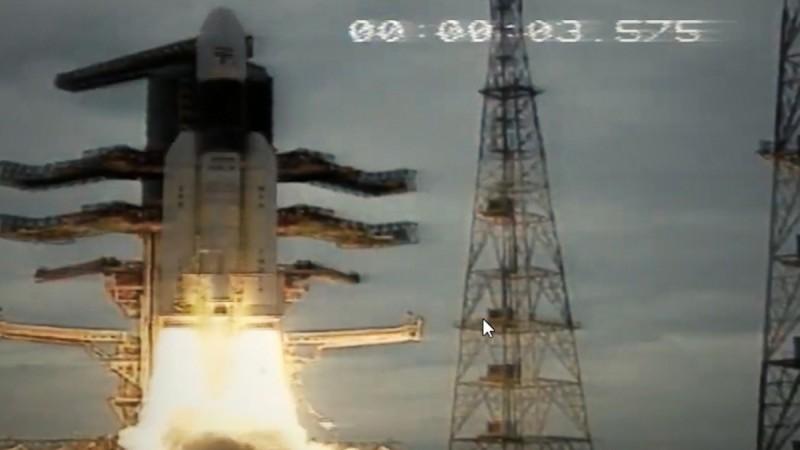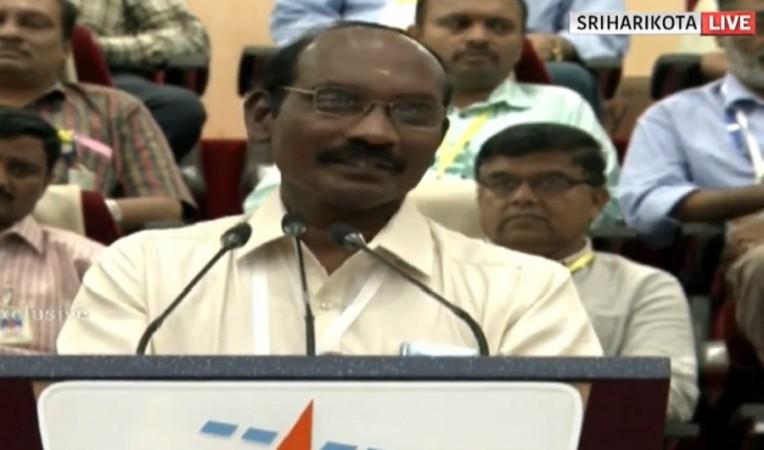Leaders from across the political spectrum on Monday applauded the successful launch of the Chandrayaan-2 Mission and termed it a proud moment for the country.
Soon after India's second lunar mission 'Babubali' GSLV rocket put Chandrayaan-2 into the orbit, President Ram Nath Kovind and Prime Minister Narendra Modi called the launch historic and a proud moment for all the countrymen.
"The historic launch of Chandrayaan-2 from Sriharikota is a proud moment for all Indians. Congratulations to our scientists and engineers for furthering India's indigenous space programme. May ISRO continue(s) to master new technologies and continue to conquer new frontiers," the President tweeted.
Vice-President M. Venkaiah Naidu said the landing of Chandrayaan-2, "an indigenously developed spacecraft launched by India's most powerful rocket GSLV MKIII, on the moon in a few weeks would make India the fourth country to do so."
Noting that Chandrayaan-2 will be the first spacecraft to land close to the moon's South Pole in some 50 days from now, he said, "The mission is expected to lead to new discoveries and enrich our knowledge systems. I wish the Chandrayaan-2 team every success."
Modi called it a special moment "that will be etched in the annals of our glorious history!"

Along with congratulating the ISRO team for "setting yet another benchmark in the field of space technology", Union Home Minister Amit Shah also thanked Modi for encouraging "institutions for setting new standards every time".
Union Ministers Nirmala Sitharaman, Rajnath Singh and Piyush Goyal too congratulated the ISRO team.
"If lunar landing of Apollo 11 was hailed as 'giant leap for mankind' the launch of Chandrayaan-2 will be remembered as a 'giant leap for womankind.' Congratulations to the ISRO team, led by space scientists M. Vanitha and Ritu Karidhal, for India's leap to the lunar south pole," Union Minister Hardeep Singh Puri said.
Former Union Minister Sushma Swaraj wished the mission a grand success.
The Congress also congratulated the ISRO team for the successful launch of Chandrayaan-2 and recalled country's first Prime Minister Pandit Jawaharlal Nehru.
"This is a good time to remember the visionary move of India's first PM Pandit Jawaharlal Nehru to fund space research through INCOSPAR in 1962, which later became ISRO. And also Dr Manmohan Singh for sanctioning the Chandrayaan-2 project in 2008," the Congress tweeted.
Chief Ministers of Delhi (Arvind Kejriwal), Chhattisgarh (Bhupesh Baghel), Telangana (K. Chandrashekar Rao), and Uttar Pradesh (Yogi Adityanath) also called the mission historic and congratulated the ISRO team.
The Geosynchronous Satellite Launch Vehicle-Mark III (GSLV-Mk III) blasted off from the second launch pad at the Satish Dhawan Space Centre (SDSC) in Sriharikota spaceport at 2.43 p.m.
About 16 minutes into its flight, the rocket put into orbit Chandrayaan-2 to begin its 48-day journey to the Moon. The success of the mission will make India the fourth country in the world to land a vehicle and travel on the Moon surface after the US, Russia and China.
Set to traverse 384,400 km in 48 days
The Rs 375 crore, heavy lift GSLV-Mk III rocket slung the Rs 603 crore, 3.8 tonne Chandrayaan-2 spacecraft in its intended earth parking orbit. The 43.4-metre tall, 640 tonne rocket, nicknamed 'Bahubali', carried the 3.8-tonne Chandrayaan-2 spacecraft, which will carry out India's second mission to its closest celestial neighbour. From here, it will be a long, over one-and-a-half-month journey for Chandrayaan-2 as it will traverse the 384,400 km that separate Earth and its sole satellite.
After the launch, Indian Space Research Organisation (ISRO) Chairman K. Sivan said: "Today is a historic day for science and technology in India. I am extremely happy to announce that GSLV-Mk III injected Chandrayaan-2 into the defined orbit. This is the beginning of a historical journey for India to land on the moon in the South Pole, to explore the unexplored.
"We had encountered a serious technical snag, but we fixed it. Team ISRO bounced back with flying colors. The team identifed the root cause of the failure in 24 hours. The snag was fixed in 1.5 days and tests were made to check the systems. The expert team was on the job for the past seven days to check the systems."
"For the past 1.5 years, the satellite team burned midnight oil to realise the Chandrayaan-2 spacecraft. Now the mantle has been given to the satellite team. They will do 15 crucial manoeuvresover over the next 1.5 months. It is going to be 15 minutes of terror to safely land the Vikram lander on the South Pole of the moon. The world has been waiting for this mission," Sivan added.
The Geosynchronous Satellite Launch Vehicle-Mark III (GSLV-Mk III) blasted off from the second launch pad at the Satish Dhawan Space Centre (SDSC) in Sriharikota spaceport at exactly 2.43 pm to begin its ascent into space.

About 16 minutes into its flight, the rocket put into orbit Chandrayaan-2 that comprises three segments — the Orbiter (weighing 2,379 kg, eight payloads), the lander 'Vikram' (1,471 kg, four payloads) and rover 'Pragyan' (27 kg, two payloads) — to begin its 48-day journey to the Moon while the ISRO will raise the spacecraft's orbit by a series of manoeuvres to put it on Lunar Transfer Trajectory in the coming days.
Originally the rocket was to fly July 15, at 2.51 am but due to a technical glitch, the mission was called off one hour before take-off.
After setting right the technical snag, the ISRO launched the rocket Monday afternoon. According to an ISRO official, the lander Vikram will land on the moon September 7. "Since this is the first moon landing mission of ISRO, we had built in buffer time which is being used now," an ISRO official had told IANS.
As per the July 15 flight schedule, Chandrayaan-2's earth bound phase was 17 days and it has now been revised to 23 days as per the new schedule.
On the other hand, the lunar-bound phase which was for 28 days under July 15 flight schedule, has come down to 13 days. Originally Vikram was planned to land on the moon 54 days after the rocket's lift off but will now do it in 48 days.
The Indian space agency has named the lander in memory of country's space pioneer Vikram Sarabhai while the rover's name means wisdom in Sanskrit.
According to the ISRO, on the day of landing — estimated September 7, the lander Vikram will separate from the Orbiter and then perform a series of complex manoeuvres comprising rough braking and fine braking.
Imaging of the landing site region prior to landing will be done for finding safe and hazard-free zones. The Vikram is expected to soft-land from a height of 100 km from the Moon's surface near its South Pole — where, according to ISRO, no one has gone before — and carry out three scientific experiments.
Subsequently, the six-wheeled rover Pragyan will roll out and carry out two experiments on lunar surface for a period of one lunar day which is equal to 14 Earth days. The Orbiter with eight scientific experiments will continue its mission for a duration of one year. It will be orbiting in 100×100 km lunar orbit.
The mission also has one passive experiment from the US space agency NASA. The Indian space agency said the mission will also try to unravel the origins of the Moon.
Both the lander as well as the rover will have the Indian national flag painted on them, while the Ashoka Chakra will be imprinted on the rover's wheels. The success of Chandrayaan-2 mission will make India the fourth country in the world to land a vehicle and travel on the Moon surface after the US, Russia and China.
Manned space mission in 2022
A total number of 38 soft landing attempts have been made, so far. The success rate is 52 per cent. India launched its first Moon mission Chandrayaan-1 in October 2008, using its light rocket Polar Satellite Launch Vehicle (PSLV).
For this mission, it used the GSLV-Mk III, a three stage/engine rocket with two strap-on motors powered by solid fuel. The second stage is a core liquid fuel booster and the third is the cryogenic engine. The carry capacity is four tons.
Till date ISRO has sent up three GSLV-Mk III rockets. The first one was December 18, 2014 carrying Crew Module Atmospheric Reentry Experiment (3.7 ton). The mission was also to test the rocket's inflight structural stability.
The second and third GSLV-Mk IIIs went up June 5, 2017 and November 14, 2018 carrying communication satellites GSAT-19 (3.1 tonne) and GSAT-29 (3.4 tonne) respectively.
GSLV-Mk III will be used for India's manned space mission slated in 2022. India presently has two fully operational rockets — the Polar Satellite Launch Vehicle (PSLV) and GSLV-Mk II — with a lift-off mass of 415 tons and a carrying capacity of 2.5 tonnes.
India puts into orbit foreign satellites for a fee using its PSLV rocket. Revenue for launching satellites depends on weight of the satellite — higher the weight, higher the revenue. Foreign customers are yet to come for the GSLV-Mk II rocket.













